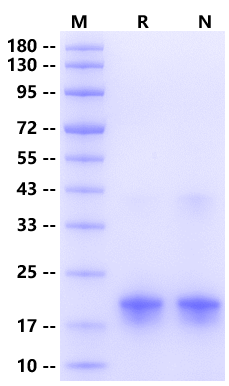· 12 months from date of receipt, -20 to -70 °C as supplied.
· 6 months, -20 to -70 °C under sterile conditions after reconstitution.
· 1 week, 2 to 8 °C under sterile conditions after reconstitution.
· Please avoid repeated freeze-thaw cycles.
Myoglobin (myoglobin,Mb) is a binding protein composed of a peptide chain and a heme auxiliary group. It is mainly distributed in myocardium and skeletal muscle. The increase of serum Mb level results from the release of skeletal muscle and / or cardiomyocyte injury (dissolution / necrosis) to blood circulation. Serum Mb < 70ng/ml, and its level varies with age, sex and race. Mb can be detected in serum in the early stage after myocardial infarction, and the peak time (1-2 hours) is earlier than creatine kinase (creatine kinase,CK). Mb is easy to be excreted from urine because of its small molecular weight. After reperfusion therapy, the level of serum Mb increases rapidly, so it has been used as a useful index to evaluate the success of reperfusion therapy or the size of myocardial infarction, but because the half-life of Mb is short (15 minutes), the level of serum Mb does not increase 6-12 hours after the attack of chest pain, which is helpful to rule out acute myocardial infarction. At the same time, because the duration of the increase of Mb level is very short (< 24 hours), the determination of Mb is helpful to observe whether there is re-infarction or infarction expansion in the course of acute myocardial infarction. The frequent increase of Mb level indicates that the original myocardial infarction is still persistent. It should be pointed out that Mb is also a component of skeletal muscle and lacks specificity, so the clinical value of a series of Mb determination after myocardial infarction is limited. For patients with chest discomfort and non-diagnostic electrocardiographic manifestations, acute myocardial infarction can not be diagnosed by Mb alone within the first 4-8 hours of onset, but should be supplemented by more specific examinations, such as CK-MB or cardiac troponin.
